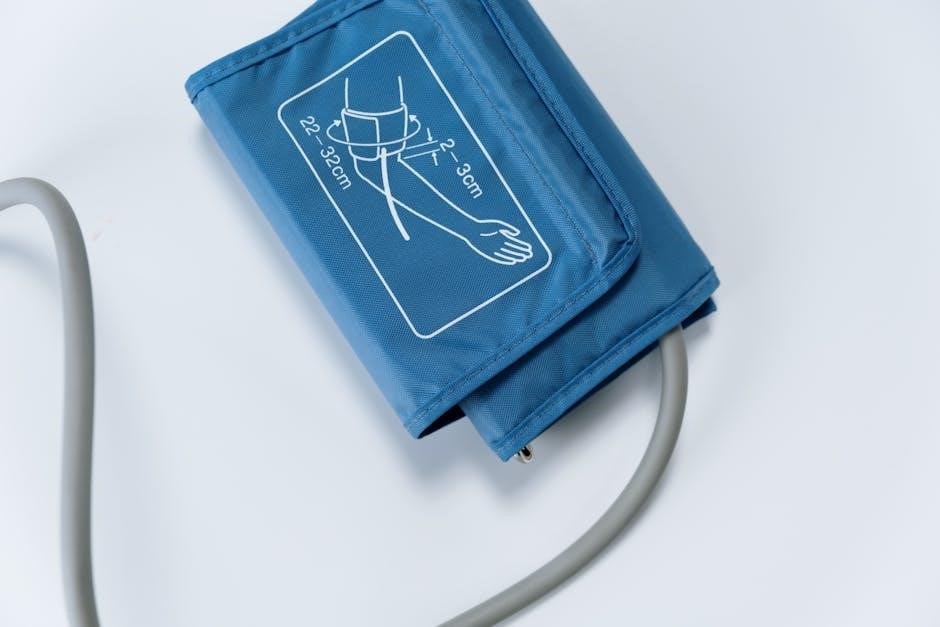The cardiovascular system, essential for overall health, transports oxygen, nutrients, and hormones throughout the body via blood circulation, maintaining cellular function and vitality, while preventing disease.
Components of the Cardiovascular System
The cardiovascular system comprises the heart, blood vessels, and blood, working together to circulate oxygen, nutrients, and hormones, sustaining life and enabling bodily functions efficiently.
2.1 The Heart
The heart is a muscular, four-chambered organ that pumps blood throughout the body. It consists of the left and right atria and ventricles, with valves ensuring proper blood flow direction. The septum separates the chambers, preventing mixing of oxygenated and deoxygenated blood. The heart’s electrical conduction system, including the SA and AV nodes, regulates rhythmic contractions. Cardiac muscle cells, or cardiomyocytes, enable the heart to function tirelessly, pumping approximately 2,000 gallons of blood daily. The heart’s efficiency is crucial for maintaining blood pressure and overall circulation, making it the cornerstone of the cardiovascular system.
2.2 Blood Vessels
Blood vessels are tubular structures that transport blood throughout the body. They are categorized into arteries, veins, and capillaries. Arteries carry oxygen-rich blood away from the heart, while veins return oxygen-depleted blood to the heart. Capillaries, the smallest vessels, facilitate the exchange of oxygen, nutrients, and waste products with tissues. Blood vessels regulate blood pressure and flow through muscular walls and elastic fibers. Their endothelial lining ensures smooth blood movement, preventing clotting. Proper functioning of blood vessels is vital for maintaining circulation, delivering oxygen, and supporting overall bodily functions. Any dysfunction can lead to cardiovascular disorders, emphasizing their critical role in health and disease prevention.
2.3 Blood
Blood is a vital liquid tissue that circulates through the cardiovascular system, consisting of red blood cells (RBCs), white blood cells (WBCs), platelets, and plasma. RBCs carry oxygen, bound to hemoglobin, to tissues, while WBCs defend against infections. Platelets are essential for blood clotting, preventing excessive bleeding. Plasma, the liquid portion, transports nutrients, hormones, and waste products. Blood maintains homeostasis, regulates pH, and supports immune function. Its composition and function are critical for overall health. Any imbalance, such as anemia or clotting disorders, can lead to serious health issues, emphasizing the importance of blood in sustaining life and preventing disease. Proper blood circulation ensures all bodily systems function optimally, making it a cornerstone of cardiovascular health.

Functions of the Cardiovascular System
The cardiovascular system transports oxygen, nutrients, and hormones, removes waste, regulates temperature, and supports immune function, maintaining overall health and bodily homeostasis efficiently.
3.1 Circulation of Blood
Blood circulation is the process by which the cardiovascular system transports blood throughout the body. It involves the heart pumping blood through arteries, which then distribute it to smaller arterioles and capillaries. In the capillaries, oxygen and nutrients are exchanged for carbon dioxide and waste products. The blood then returns to the heart via veins, completing the cycle. This continuous process ensures that all tissues and organs receive the necessary supplies for proper function. Efficient blood circulation is crucial for maintaining overall health, as it supports cellular metabolism, immune response, and the removal of waste materials. Any disruption in this process can lead to various health issues.
3.2 Oxygen Delivery
Oxygen delivery is a critical function of the cardiovascular system, ensuring that oxygen from inhaled air reaches tissues and organs. The heart pumps oxygen-rich blood from the lungs through arteries to capillaries, where oxygen diffuses into cells. This process is essential for cellular respiration, enabling cells to produce energy. The efficiency of oxygen delivery depends on factors like blood flow, hemoglobin levels, and capillary density. Poor oxygen delivery can lead to fatigue, organ dysfunction, or tissue damage. The cardiovascular system adapts to increased demand by enhancing blood flow, such as during exercise. This vital function underscores the importance of a healthy cardiovascular system in maintaining overall well-being and preventing conditions like hypoxia or anemia.

Significance of the Cardiovascular System
The cardiovascular system is vital for maintaining life, serving as the body’s transport network. It delivers oxygen and nutrients to cells while removing waste products, enabling proper cellular function and overall health. Without this system, organs and tissues would rapidly fail due to lack of essential resources. The cardiovascular system also plays a key role in immune defense and hormone distribution, connecting all body parts. Its efficiency directly impacts energy levels, physical performance, and mental clarity. Dysfunction in this system can lead to severe health issues, such as heart disease or stroke, highlighting its critical importance. Maintaining cardiovascular health is essential for preventing diseases and ensuring longevity, making it a cornerstone of overall well-being.

Common Diseases of the Cardiovascular System
The cardiovascular system is prone to diseases like hypertension, coronary artery disease, heart failure, and stroke, which impair blood flow and organ function, requiring timely medical intervention.
5.1 Hypertension
Hypertension, or high blood pressure, is a prevalent cardiovascular condition where blood pressure exceeds 140/90 mmHg. It can lead to complications like heart disease, stroke, and kidney damage if untreated. Symptoms often go unnoticed, but severe cases may cause headaches or dizziness; Risk factors include obesity, poor diet, lack of exercise, and genetics. Early detection through regular blood pressure checks is crucial. Management strategies include lifestyle changes, such as adopting a low-sodium diet, increasing physical activity, and quitting smoking. Medications like ACE inhibitors or diuretics may also be prescribed. Untreated hypertension can lead to heart failure or arterial damage, emphasizing the importance of timely intervention and adherence to treatment plans. Regular monitoring and healthcare provider guidance are essential for managing this condition effectively.
Diagnostic Tests for Cardiovascular Health
Diagnostic tests are crucial for assessing cardiovascular health and detecting potential issues early. Common tests include electrocardiograms (ECG) to measure heart activity, echocardiograms to visualize heart structure, and stress tests to evaluate heart function during exercise. Blood tests, such as lipid profiles, help identify high cholesterol or inflammation. Imaging techniques like MRI or CT scans provide detailed views of blood vessels and organs. Angiograms are used to detect blockages in arteries, while blood pressure monitoring helps diagnose hypertension. These tests enable healthcare providers to identify risks, diagnose conditions, and guide treatment plans, ensuring timely interventions to prevent complications and improve patient outcomes.

Risk Factors for Cardiovascular Diseases
Several factors increase the likelihood of developing cardiovascular diseases. Lifestyle-related risks include smoking, an unhealthy diet, physical inactivity, and excessive alcohol consumption. High cholesterol and diabetes are significant contributors, as they damage blood vessels and impair blood flow. Obesity is another major risk factor, often leading to hypertension and metabolic syndrome. Age and gender also play a role, with risks generally increasing after 55 years and being higher in males. Additionally, family history of heart disease can predispose individuals to these conditions. Managing these risks through lifestyle changes and medical interventions is crucial for maintaining cardiovascular health and preventing complications.
Management and Treatment Options
Managing cardiovascular diseases involves a combination of lifestyle modifications, medications, and surgical interventions. Lifestyle changes include adopting a heart-healthy diet, regular exercise, and quitting smoking. Medications such as statins, beta-blockers, and anticoagulants help control cholesterol, blood pressure, and prevent clots. For severe cases, procedures like angioplasty, stent placement, or coronary bypass surgery may be necessary. Rehabilitation programs are often recommended to improve cardiac function and reduce future risks. Early diagnosis and tailored treatment plans are crucial for effective management and improving patient outcomes. Regular monitoring and adherence to medical advice are key to maintaining long-term cardiovascular health.
Future Directions in Cardiovascular Medicine
Future advancements in cardiovascular medicine focus on personalized treatments, advanced diagnostics, and innovative therapies. Emerging technologies like gene therapy and stem cell regeneration aim to repair damaged heart tissue. Wearable devices and AI-driven monitoring enable early detection and prevention of cardiovascular events. Researchers are also exploring nanoparticle-based drug delivery systems to target specific cardiac cells. Additionally, bioartificial hearts and 3D-printed heart models are being developed for transplantation and research. The integration of telemedicine and remote patient monitoring promises to improve access to care, especially in underserved areas. These innovations highlight a promising future for cardiovascular health, emphasizing precision, accessibility, and sustainability in patient care.







